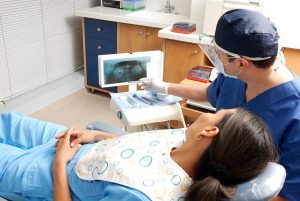Written by Harold Oster, MD. Results suggest that diabetics with periodontitis are more likely than non-diabetics to have low vitamin D levels and a diet low in fruits and vegetables.
 Periodontitis is a chronic condition of the support structures of the teeth. Chronic inflammation leads to bleeding, pain, and, eventually, tooth loss. The prevalence of periodontitis in the United States is nearly 40%1. Risk factors for the development of periodontitis include poor nutrition2, vitamin D deficiency3, and diabetes4.
Periodontitis is a chronic condition of the support structures of the teeth. Chronic inflammation leads to bleeding, pain, and, eventually, tooth loss. The prevalence of periodontitis in the United States is nearly 40%1. Risk factors for the development of periodontitis include poor nutrition2, vitamin D deficiency3, and diabetes4.
Arpita Basu et al. studied metabolic and dietary variables and clinical indices of periodontitis in those with and without diabetes. Seventy-eight adults with periodontitis, defined as having four teeth in two quadrants with a pocket probing depth of at least 5 mm, dental clinical attachment loss of 3 mm or more, and bleeding upon probing5, were recruited from a dental clinic in Nevada. Information regarding demographics, clinical indices of periodontitis, medical history, and nutrition was gathered from the participants’ recent clinic visits. From the participants, 25 diabetics and 25 non-diabetics, matched for age and body mass index, were selected for additional study. These participants provided a dietary recall survey for two to three days, and their blood was tested for vitamin D levels, C-reactive protein (a test for inflammation), and hemoglobin A1c (a measure of diabetes control).
The authors noted the following:
- Hypertension and hyperlipidemia were more common in diabetics, while alcohol use was less common.
- Tooth retention, bone loss, and pocket depths greater than 4 mm or deeper were lower in diabetics than non-diabetics.
- A greater percentage of diabetics measured high on a standard caries risk assessment tool6.
- Of those tested, the mean vitamin D level was in the insufficient range (24 ng/mL), and diabetics had lower vitamin D levels than non-diabetics (21 ng/mL vs 31 ng/mL).
- C-reactive protein levels were higher in diabetics than non-diabetics (5.3 mg/dL vs 3.8 mg/dL, with normal being less than 1.0 mg/dL7.
- 67% of participants in the overall group failed to meet the guidelines for fruit and vegetable consumption of five servings a day8.
- Diabetics ate less fruit and vegetables than non-diabetics (0.2 vs 0.4 cups per day of fruit and 0.3 vs 0.5 cups per day of vegetables).
The authors concluded that diabetics with periodontitis were more likely than non-diabetics to have inadequate fruit and vegetable intake and low vitamin D levels, known risk factors for periodontitis. Limitations include the lack of a control group without periodontitis, reliance on a dietary survey to assess intake of fruit and vegetables, and the possibility of residual confounding.
Source: Basu, Arpita, Leigh Ann Richardson, Alicia Carlos, Neamat Hassan Abubakr, Robin L. Weltman, and Jeffrey L. Ebersole. “The Associations of Cardiometabolic and Dietary Variables with Clinical Periodontitis in Adults with and without Type 2 Diabetes: A Cross-Sectional Study.” Nutrients 16, no. 1 (2023): 81.
© 2023 by the authors. Licensee MDPI, Basel, Switzerland. This article is an open access article distributed under the terms and conditions of the Creative Commons Attribution (CC BY) license (https://
creativecommons.org/licenses/by/4.0/).
Click here to read the full text study.
Posted January 24, 2024.
Harold Oster, MD graduated from medical school in Miami, Florida in 1992 and moved to Minnesota in 2004. After more than 25 years of practicing Internal Medicine, he recently retired. Dr. Oster is especially interested in nutrition, weight management, and disease prevention. Visit his website at haroldoster.com.
References:
- O’Dwyer MC, Furgal A, Furst W, et al. The Prevalence of Periodontitis Among US Adults with Multimorbidity Using NHANES Data 2011-2014. J Am Board Fam Med. Apr 3 2023;36(2):313-324. doi:10.3122/jabfm.2022.220207R1
- Van Dyke TE, Sheilesh D. Risk factors for periodontitis. J Int Acad Periodontol. Jan 2005;7(1):3-7.
- Botelho J, Machado V, Proença L, Delgado AS, Mendes JJ. Vitamin D Deficiency and Oral Health: A Comprehensive Review. Nutrients. May 19 2020;12(5)doi:10.3390/nu12051471
- Preshaw PM, Alba AL, Herrera D, et al. Periodontitis and diabetes: a two-way relationship. Diabetologia. Jan 2012;55(1):21-31. doi:10.1007/s00125-011-2342-y
- Salvi GE, Roccuzzo A, Imber JC, Stähli A, Klinge B, Lang NP. Clinical periodontal diagnosis. Periodontol 2000. Jul 14 2023;doi:10.1111/prd.12487
- Cagetti MG, Bontà G, Cocco F, Lingstrom P, Strohmenger L, Campus G. Are standardized caries risk assessment models effective in assessing actual caries status and future caries increment? A systematic review. BMC Oral Health. Jul 16 2018;18(1):123. doi:10.1186/s12903-018-0585-4
- Kushner I, Antonelli MJ. What should we regard as an “elevated” C-reactive protein level? Ann Intern Med. Aug 18 2015;163(4):326. doi:10.7326/l15-5126
- Services USDoAaUSDoHaH. Dietary Guidelines for Americans 2020 – 2025. https://www.dietaryguidelines.gov/sites/default/files/2021-03/Dietary_Guidelines_for_Americans-2020-2025.pdf
